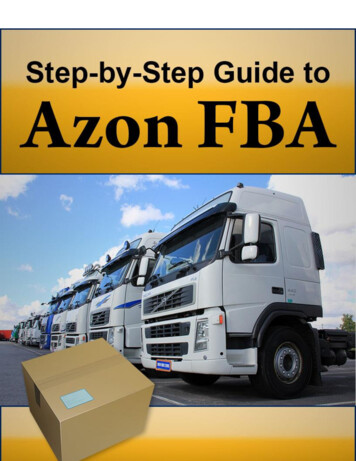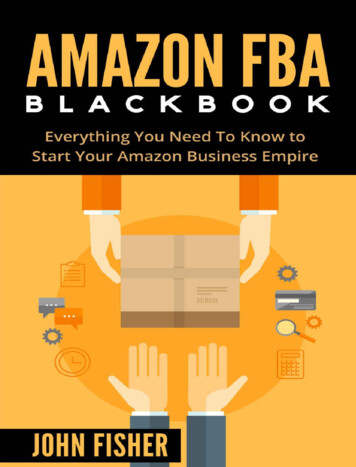
Transcription
Amazon FBA BlackbookEverything You Need toKnow to Start YourAmazon Business Empire
Copyright 2015 - All rights reserved.In no way is it legal to reproduce, duplicate, or transmit any part of this documentin either electronic means or in printed format. Recording of this publication isstrictly prohibited and any storage of this document is not allowed unless withwritten permission from the publisher. All rights reserved.The information provided herein is stated to be truthful and consistent, in that anyliability, in terms of inattention or otherwise, by any usage or abuse of any policies,processes, or directions contained within is the solitary and utter responsibility ofthe recipient reader. Under no circumstances will any legal responsibility or blamebe held against the publisher for any reparation, damages, or monetary loss due tothe information herein, either directly or indirectly.Respective authors own all copyrights not held by the publisher.Legal Notice:This book is copyright protected. This is only for personal use. You cannot amend,distribute, sell, use, quote or paraphrase any part or the content within this bookwithout the consent of the author or copyright owner. Legal action will be pursuedif this is breached.Disclaimer Notice:Please note the information contained within this document is for educational and
entertainment purposes only. Every attempt has been made to provide accurate,up to date and reliable complete information. No warranties of any kind areexpressed or implied. Readers acknowledge that the author is not engaging in therendering of legal, financial, medical or professional advice.By reading this document, the reader agrees that under no circumstances are weresponsible for any losses, direct or indirect, which are incurred as a result of theuse of information contained within this document, including, but not limited to, —errors, omissions, or inaccuracies.
Everything You Need to Know to Start Your AmazonBusiness EmpireIntroductionChapter 1: Amazon Is the Best Place to SellChapter 2: The Importance of Private LabelingHow to Choose the Best Private Label Products forAmazon FBAKeep it Simple5 More Rules for Private Label Selling on Amazon FBAYou Need CapitalYou Are Not Going to Get Any Quick WinsKnow Who Your Customers Are and Keep Your RisksLowYou Are Not an Amazon Reseller So Stop Thinking LikeOneDon’t Forget to Build on the Success of Your WorkChapter 3: Setting up a Seller AccountSetting up Your Seller Profile
About Seller Your Logo Your Return and Refunds PoliciesChapter 4: Picking a Great ProductGood Sales VolumeAttractive PricingNiche ProductNon-Seasonal ProductNecessary CompetitionGood SupplierMobilityProfitabilityViability ChecklistMarket ViabilityProduct ViabilityChapter 5: Finding the Right SuppliersShipment MethodsPrivate Shipping
Fulfillment by AmazonDrop ShippingPrivate LabelingThe Importance of SamplesCostingsHow to Use Your SamplesChapter 6: Listing Your Product on AmazonWrite a Captivating Sales DescriptionAddress the customerMention the benefits, not the featuresTechnicalitiesImpressive wordingGraphic descriptionFormattingHighlightingProofNo nonsenseOutsourcing and supervision
Chapter 7: Sending the Product for FBAWhat is FBA?Benefits of FBAHow FBA FunctionsHow to get paid with FBAChapter 8: Brand PromotionBecoming a Top SellerQuality productsTimely shippingFair pricesCustomer satisfactionHigh-quality photosProduct descriptionsDealing with complaintsThe Importance of Building an Email ListHow to Get StartedGetting Started – The Basics of Building an Email List Find a Good Email Marketing Service
Come Up with the Right Temptation Create Your Opt-In Form Insert the Opt-In Form on Your WebsiteThe Next Step – Getting People to Subscribe Utilize Lists from Other People Add Your Opt-In Form to Another Form Have a Contest or a GiveawayChapter 9: Amazon Fees – Is the Cost Worth It?How Much Does it Cost?Referral FeeAmazon FBA and Selling on AmazonConclusion
IntroductionSo you hear the calling. Amazon, the king of online retail,calls to you. You see a great opportunity here, becauseAmazon is already the biggest in the market, and willcontinue to dominate. There are so many who want to jumpon this bandwagon and enjoy the benefits of selling onAmazon.You’re among these people, and you want to set up abusiness without investing too much capital. But you don’tknow how to go about it. Well, that’s what this book is for.First of all, thank you for downloading “Amazon FBABlackbook: Everything You Need to Know to Start YourAmazon Business Empire”. In this book, we will see howyou can start your very own Amazon trading business in notime and with minimal capital. I will show you the power ofAmazon, and how you can use it to your advantage.Unlike those “Get Rich Quick” books you find on the Internet
all the time (which are total gimmicks, by the way), this bookcontains actual strategies used by thousands of people. Yes,you will have to put in some efforts, but it will be worth thepay-off, trust me. People have created million dollar empireswith these strategies, and so can you.So let’s get started.
Chapter 1: Amazon Is the Best Place toSellSellers have a lot of choices these days because so manyonline retail websites have popped up in the market. Peoplecan sell their material through so many platforms and make aquick buck by selling off their old stuff. You can also start aserious business if that’s what you want. Most of these ecommerce platforms don’t care either way. So making achoice between popular ones can be difficult.If you’re in for serious business, though, Amazon is the bestchoice for you. There are so many things Amazon makes easyfor you. Here are some convincing reasons why Amazon isthe best place to start your e-retail business:Great Pricing: Amazon gives its sellers the most competitive prices in themarket. Amazon’s ASP, or Average Selling Price, for most items is higher thanmost other similar sites, especially for the items it sells through FBA (Fulfillmentby Amazon). Another great thing at Amazon is that customers that show up onthere are looking for options and ease of shopping, not for the lowest prices orvery unique products.
Simplicity: The interface Amazon provides to its sellers is known for its eleganceand simplicity, much like its customer platform. It’s much more efficient andprofessionally competent when compared to that of so many other e-retailplatforms. With Amazon, things are so much easier for you because you don’thave to work with multiple third party platforms like PayPal. 9 out of 19 times, youcan even get rid of most of your duties, like listing the product, managing yourfees, getting products shipped, and shooting high quality photos for your products.Amazon makes everything in the trade work for you.Visibility: It’s much harder for small sellers to get visibility for themselves andtheir products on most e-retail platforms. They start out as a tiny part of this hugesystem, and it’s really difficult to get to the top. Amazon gives small sellers muchbetter visibility than any other platform. This is because Amazon uses a rotatingsearch algorithm, which keeps shuffling search results for customers from time totime, giving new sellers better exposure. If you can afford to, you can even buysponsored links, which will drive much more traffic toward your products andboost your sales. You’ll make healthy sales if you have a solid product.Listing Fee: Most people who have worked in this business before have a fairidea about the margins. They’re really tight, aren’t they? That’s the main reason
why every seller wants to minimize his listing fees. Once again, Amazon comes toyour aid and saves you money. On Amazon, you don’t have to pay any listing feeat all for most items. Some special types still require a listing fee, but it’s sominimal compared to other platforms that you’ll gladly pay it. This helps you keepyour inventory flexible because your upfront costs are minimized.Easy Order Fulfillment: Most e-retail platforms don’t care about your shippingneeds and how you’re going to be able to ship your products to the customers ontime. Amazon is different, and it makes your headache its own! If you want,Amazon can take care of all your orders and fulfill them for you. You don’t haveto work hard to fulfill orders yourself or maintain links with fulfillment partners.Amazon takes care of it for you, making your job much easier and the systemrunning more smoothly.Overhead Costs: Overhead costs are inevitable in any business, and every sellerwants to minimize them. Amazon emerges as a champion for the sellers here, too.It helps you cut down your overhead costs in so many ways. You don’t have tospend on getting high-resolution photos for your products, pay any listing fee ormaintenance cost most of the times. You even save up on communication time.This makes Amazon one of the cheapest platforms available today.
Growth Prospects: Amazon leads the e-retail industry and it will continue to doso for the foreseeable future because of its efficiency and love for innovation. Themarket is expanding and Amazon will continue to grab a big part of it, therebymaximizing your exposure. This is the place for you to grow.Integration: If you’re among those people who don’t want to deal with thetrouble of interacting with a payment provider like PayPal, market researchprovider like TeraPeak, fulfillment partner like ShipWire or Fulfillrite, and don’twant to choose what tools and listing formats to use, you should go with Amazon.It makes everything streamlined and easy to access for you without you having tomake a lot of hard choices. You can do away with learning how to navigatethrough all these different services and manage everything from a single interface.You have full integration with all sorts of services, and everything can becontrolled from your Amazon account.Stability: Amazon has one of the most stable and efficient interfaces. It functionssmoothly and isn’t prone to frequent changes, so you don’t have to go through alearning curve every so often. So many other platforms keep changing theirinterface and workflows just to seem dynamic, but that can pose a problem tosellers. Amazon is very stable, so you don’t have to worry too much about theconstantly changing demographics, marketplace rules, fees, and features.
Chapter 2: The Importance of PrivateLabelingPrivate labeling is very popular at the moment, so youmight’ve heard of it most probably. Most online retailers useprivate labeling for their products these days. This gives theproducts a unique identity that showcases the seller’s brand.Private labeling also helps in marketing the product betterand creating a reputation for your brand. But how does it allhappen?First, you buy the products from a supplier to sell them underyour brand name. You don’t actually manufacture them,which is the conventional way of doing business. You createa private brand and then put all the bought products underthat brand so you can resell them. For this, you need to getcustom logos printed on the items and their packages, and getthe previous brand identities (if any) removed. This ensuresthat the customer will associate the product with your brand,not with that of the manufacturer. This strategy is extremelypopular right now and most online sellers use it. You can
find companies that will help you in creating your own brandidentity. They’ll advise you on extending, promoting, andpositioning your brand in the market, so you can make thebest of it. J&D Consortium is a good example of such acompany.Let me tell you how a private label brand on your productshelps your business.Easier to handle: Trading is easier than manufacturing, that’s pretty obvious.There’s a lot less trouble in comparison, so throw away any misconceptions youmight have about private labeling. Some people believe that selling products youmanufacture yourself is the only way to roll and that private label products don’tsell. Let me tell you that nothing could be further from the truth. As long as youhave a good quality product that you’re selling at a fair price, nobody cares whomanufactured it. Avoid huge costs and sell under a private label, it’s a wisedecision.Modification: With private labeling rights, you can make some modifications tothe products according to your needs and wishes. This means you can make yourproducts unique without having to come up with groundbreaking product ideas.Take products already existing in the market and make small changes to them togive them a personality. Private labeling is different from reselling, as reselling
rights don’t allow you to make any modifications, which isn’t the case with privatelabeling rights. So come up with new ideas and incorporate them into your productdesign. It’s your product, do what you want!Customer Satisfaction: Private labeling makes things easier for you by removingsteps in your business journey. First of all, when you do private labeling, you won’tneed to spend time on product conceptualization, which is pretty difficult by theway. Even if you come up with a good product concept, someone will do it betterthan you in all probability, and you’ll have to start over again. There are manygiants in almost every industry niche, so it’s futile to try and beat them at their owngame. Instead, just buy the products and give them your personal brand. This way,you can concentrate on other important things, like customer satisfaction. Yourmaximum attention will go to your customers, because you don’t have to worryabout stuff like personnel management, product planning, efficiency control, andother big tasks.Riding the B andwagon: When you introduce a new product in the market, it’salways risky. New ideas tend to be like that in nature. They’ll either be super flopor super hit most of the times, and one can never be sure. A high margin of errormakes things expensive and difficult for the manufacturer if the product fails. It’snot the road for everyone. Private labeling, however, is much easier. You don’t
have to worry about losing money since you can pick an already popular productand sell it under your private label brand to benefit from its popularity. You’ll get acustomer base with minimal effort, and without having to spend much money onpromotion.
How to Choose the Best Private Label Products for Amazon FBAOne of the most popular practices for selling on AmazonFBA is private label products but the problem that mostpeople struggle with is working out which products to sell,what the best ones are to build up their own brand around.There are people who choose the complicated route,choosing items that need a lot of modification and cost afortune to produce and there are those who choose the easierroute.The first question to ask yourself is why you are choosingprivate labelling. Most people choose to use Amazon tocreate their brand are those who are fed up with trying to finddecent goods on EBay that they can flip on Amazon for aprofit, or vice versa. Reselling is not a good game to get into– it might bring you a little extra cash but it will never be astable income and there is a lot of work involved.Private label products give you the best chance at aconsistent and relatively passive income while keeping laborand time to a minimum as well as overheads. Most peoplecan see the real benefits to building their brand around
private label products, without the need to keep on lookingfor new ones to keep the money rolling in. However, there isone huge hurdle that stands in their way of true success –unnecessary complication.
Keep it SimpleIt is easy to see the benefits of brand building but the morecomplex a product you choose, the more work has to be putinto it and that should lead to a much higher chance ofgenerating revenue. Ok, that may be true; after all, the iPhoneis far more valuable than a pack of plastic food containersbut building a new iPhone does not mean that people aregoing to buy it. The most success, the most money you make,will come from simple items.When it comes down to the crunch, the best private labelproducts to build your brand around are simple and, if youflow these rules, you will find it works. Ask yourself thesequestions before you put your money down on a particularproduct:Is it evergreen? Will your customer keep oncoming back to it, time and time again? Think aboutthings like shampoo or conditioner – items thatpeople will buy over and again.Is your product one that people are looking for?Imagine that you just blew a couple of thousand
dollars on a product, branded it and then found thatnobody is actually looking for that particularproduct. Not just your actual brand, but the producttype itself. How would you feel? Gutted? Stupid?Do your homework first. There is an easy way tofind out what people are looking for on Amazon,before you lay out your life savings and that is torun a keyword search on Amazon. You can do thisby typing in specific keywords to the search bar onAmazon and see what the results are o you can useone of the many automatic tools to search for you.Some of these tools will tell you what has beensearched for on specific listings and others willidentify market gaps that you can think aboutjumping into.Does your product have tons of competition? Ifyou choose a product that is extremely common onAmazon, you might struggle to get your foot in thedoor. However, there are quite a few products thatare lacking in competition and these are the onesthat you should look at. Even if the item does have
competition, consider if you can come up withsomething the competition can’t, like providingmultiples.How easy and cheap is the product to produce?You do not need to sell expensive items that cost afortune to make and involve a lot of modification.It’s better to sell 15 units of plastic container packsa day at 20 each than it is to sell a phone once in awhile that as an extremely low profit margin.Is there any proven sales data against thisproduct? One step that many people skip over istesting their Amazon listing with retail storeproducts, before choosing to place a bulk order.This is an important step, one that will prove ifyour product will sell before you start theexpensive step of sourcing your product from amanufacturer.Really, there is nothing too scientific or difficult about this.The very best products to sell private label are simple ones.Items that will stand the test of time, products that peoplecome back to time and time again.
5 More Rules for Private Label Selling onAmazon FBABy now, you should already know how to get going withprivate label selling on Amazon FBA. However, there arestill those that think it is going to be a simple job and thatthey can make money instantly. The following are the fivemost important rules to private label selling on Amazon:You Need CapitalThis is the most important rule – you cannot make moneywith private label selling unless you have the capital to layout in the first place. You can’t buy your stock, build yourbrand, and design your packaging, without having a lot ofcapital to start off with. Creating your very own private labelis NOT the same as finding a resell product to flip onAmazon. You need the money to buy your product in bulk, topay for any modifications that you might want and that is notfree. Initially, your suppliers are not going to give you thebest deal on your chosen product and they certainly won’tbuild any prototypes for you unless you are going to purchase
vast quantities – that means money, a lot of it. If you don’thave it or are not prepared to pay out, go away and findanother avenue because you will be wasting your time.You Are Not Going to Get Any Quick WinsThere is a big difference between the person who resells onAmazon and those who come up with their own products andbrands. Those who do the latter are building up an asset,something that will bring the money in for the foreseeablefuture, whereas a reseller is simply making immediate moneyand will need to go off and find another product to sellafterwards.There is a world of difference between these two types ofpersonality. Everyone wants to make money but the personwho builds an asset knows that, even if their product onlydraws in an extra couple of hundred dollars a month, it is farsuperior and lasts a lot longer than the person who flips anexpensive item. Why is this?Assets are always the better option than just having theknow-how to flip a single product. Assets have a moresustainable value, they will last through time. It is far better
to have 10 assets worth, let’s say 500, making you apotential 5000 per month, every month, than resell productsthat you flip once and they’re gone.Know Who Your Customers Are and Keep Your Risks LowOne of the most profitable ways to have success with aprivate label product is to know exactly who your customersare and to understand them. And the best way to understandyour customers is to use Amazon Sponsored Ads.The stupidest thing to do would be to pick a product, talk toyour supplier, buy a whole load and stick it on Amazonexpecting to make a ton of money. It can work but it is veryrare. You need to keep your risks low when you are creatingyour private label product. Use Amazon Sponsored Ads totest out your product to ensure that this is something peoplereally want and will dig into their wallets for. You need toshift your mindset for this but learn how to use thesesponsored ads to your advantage before you pay out forsomething you can’t shift.You Are Not an Amazon Reseller So Stop Thinking Like OneLots of people get into trouble by thinking like an Amazon
reseller and not like a private label seller. To be successfuland to run a real business you have to spend time buildingyour brand and your assets. The assets you build up are goingto generate money with very little involvement from you Areseller has to start again every week or month, looking forthat next big product to flip, processing their shipments andeverything else that goes with it. A private label seller whohas done their homework can build something that is muchbigger than they are, something that lasts for the long term.Don’t Forget to Build on the Success of Your WorkLast, and most important, build on your success. The moneythat you earn from your product needs to go into creatinganother one and sustaining it. It is so tempting to take yourearnings and spend it but like anything, the more you put backin, the more you will get out.To be successful at selling private label products, you haveto keep in mind that they are not easy to create and it will bea very rare person who hits the home run the first time round.Don’t despair; do your homework and test out your productsbefore you buy them and start small. Build your business as
you go and, if you do it right, you will eventually have astable of assets that consistently generate revenue with littleinput from you.These reasons are more than good enough to convince you.As an online retailer, you should definitely consider privatelabeling, as it will take your business to the next level muchfaster.Now, let’s discuss how you can start your business withAmazon.
Chapter 3: Setting up a Seller AccountAmazon gives you a big opportunity to make money online byselling there. You can earn some extra income from it, or youcan even quit your job and set up a full time business onAmazon if you want to. It gives you a lot of freedom and youcan take out more than what you put into it.Let me list down some of the benefits of selling on Amazon:Flexible work schedule and freedom of workFinancial securityGood returns on your investmentsMore free time to enjoy the things you love doingExperience to carry out bigger projects in futureIt’s so easy that pretty much anyone can learn to do it, andthat’s the best thing about it. You have control over howprofitable your business will be. Your efficacy in applyingthe strategies mentioned would decide how successful youare. Gradually, you will also learn the ins and OUTs of thetrade, and this will boost your income further. All of that,however, comes later. Right now, we must start with some
baby steps. Creating an Amazon Seller Central account isyour first step to starting your business.The process is pretty straightforward. Amazon has givenhelpful tips to get you through it easily, and you don’t need tofollow anything else. I’ll simplify the process for you here:1)Open the following URL in your web browser”sellercentral.amazon.com.2) There will be a login page. When you click on the “Register Now”button on the login panel, it will take you to a different page.3) The first thing you have to do here is to choose whether you will beselling as an “Individual” or as a “Professional. Let’s take a look at thedifferences between these two.a) An Individual seller can only sell a maximum of 40 items in amonth. A Professional seller, on the other hand, can sell anynumber of items in a month. There are no restrictions.b) An Individual seller is charged a commission of 99 cents oneach item that he sells. There’s no monthly fee in this case. Asopposed to that, a Professional seller pays a monthly fee of 39.99. In both the cases, you may have to pay some additionalfees at times, like referral fees & variable closing fees.c) Professional sellers can sell items in all categories available onAmazon. Individual sellers can’t do that. They’re allowed to sell inonly limited number of categories. So it’s advisable that you gowith the “Professional” plan for your business.4) Once you choose a plan, you will have to read a seller agreement andsign it.5) Print out this agreement before you go any further. This will help you
iron out any issues in the future. Once you’ve read it, agree to the terms andconditions, and then proceed further.6) In the next window, you will need to fill in some important information,like your credit card details, billing address, seller name, and your businessaddress.7) After this, you will need to verify your identity. A P IN will be given toyou through a text or a phone-call on a number that you provide them. Thisis a standard procedure which many sites follow.8) A Professional seller also has to provide the necessary tax informationto Amazon in order to proceed.9) Once you’ve provided your tax information, the registration procedurewill be complete and you’ll be taken to the home page of your Seller Centralaccount. From here, you can manage all activities in your account.There are several tabs in the top navigation bar of your homepage. Let me give you a walk-through of these tabs.Inventory: You can add new products and manage existing ones fromhere.Reports: This tab lets you view all your payment reports and tax info.Orders: Check all the received orders and handle all the returns fromhere.Performance: All the feedback you receive from customers is shownhere along with any claims made by them and other performancerelated information.Settings: In this tab, you can change any account information.
Setting up Your Seller ProfileWhen your account has been activated, you will need tocomplete your public profile. This is what prospectivecustomers will look at so consider it as the Amazon versionof your Facebook or Twitter profile. Your customers will getto know who you are, what your business is all about andwhat you offer in terms of shipping. They will see yourreturns policy; they can see feedback from other customersand much more besides.The main parts of your profile that you should concentrate onare: About SellerThis section is where you get to introduce yourself and yourbusiness to your customers. You need to tell people exactlywho you are, how your business to started, what was theinspiration behind it. Talk about your business philosophy,what you want to achieve and offer to your customers and tellthem anything else that is relevant. You are trying to create aconnection to your customers and you need to be astransparent as possible. This will help to build up trust and
your customers will be more likely to choose you over yourcompetition. Your LogoProspective customers will be able to see your logo in anumber of places, including the Offer Listing page, on yourstorefront and on your At a Glance page. Keep your logo to120 x 30 pixels and do not include any URLs or references toyour website in it. Your Return and Refunds PoliciesGive your customers full instructions on how they can returnitems for a refund or a replacement. Let them now theaddress they need to send returns to and tell themapproximately how long it will take you to process a refundor send out a replacement product. When you are setting upyour policies do bear in mind that Amazon has a requirementthat all sellers allow customers to return goods for aminimum period of 30 days after the sale.With this information in hand, you can create your AmazonSeller Central account, start listing your products and makingmoney!
Chapter 4: Picking a Great ProductThis is possibly the most important step in the wholeprocess. It will all be for naught if you fail to choose a killerproduct. Why is it so important? Simply because the onlyway for your business to succeed is for you to pick a productthat sells well. For a product to sell more, it has to bemarketable. Without a great product, you can’t make yourbusiness work.So what makes a product “great”? Let’s take a look at someimportant factors.
Good Sales VolumeThis is an elementary rule of choosing a good product. Youwant to sell this product, so you need to make sure it isselling well in the market. If you pick a niche product thatonly sells a couple of units every month, you won’t beprofiting from it at all. There is too much competition in themarket, so you must pick a product that is selling big. But it’salso important that you make sur
Amazon FBA Keep it Simple 5 More Rules for Private Label Selling on Amazon FBA You Need Capital You Are Not Going to Get Any Quick Wins Know Who Your Customers Are and Keep Your Risks Low You Are Not an Amazon Reseller So Stop Thinking Like One Don't Forget to Build on the Success of Your Work Chapter 3: Setting up a Seller Account
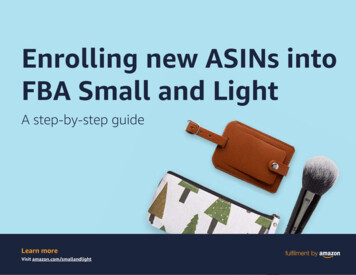


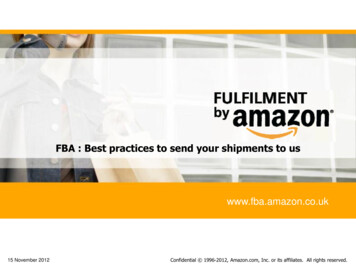
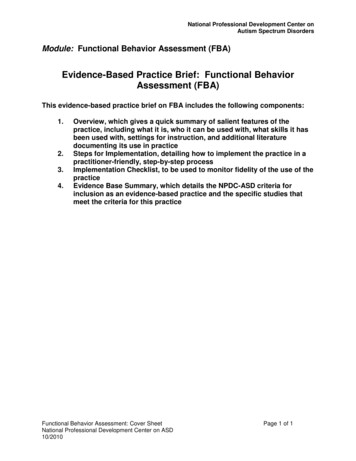



![Index [beckassets.blob.core.windows ]](/img/66/30639857-1119689333-14.jpg)
